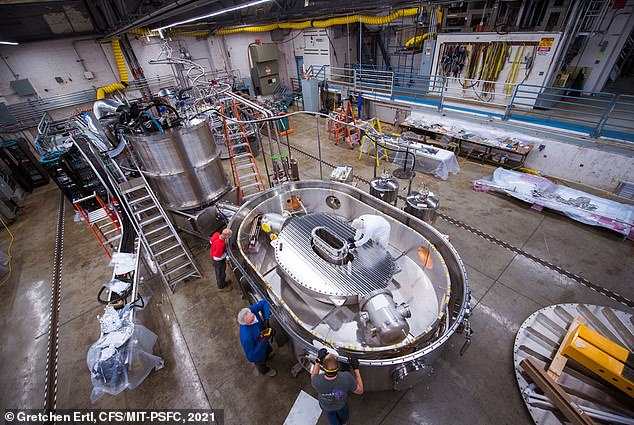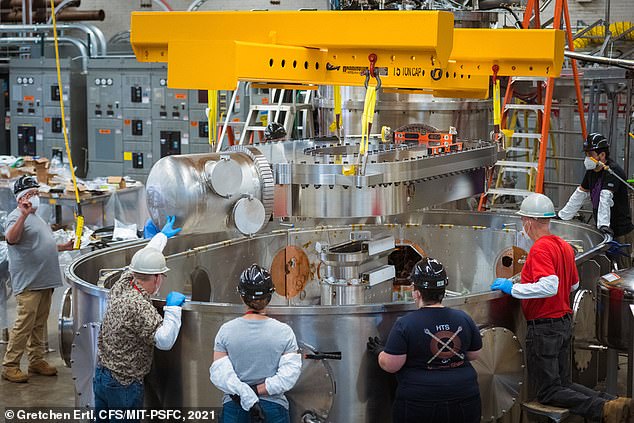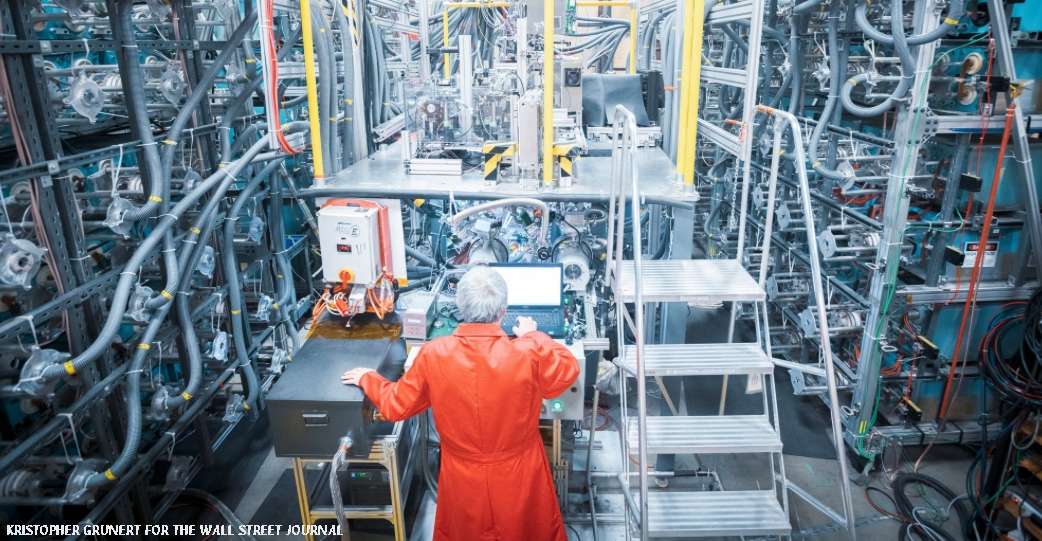Fusion Energy Is Coming, and Maybe
Sooner Than You Think
The joke about fusion energy is that it will always be 30 years away, - always. But significant recent advances in fusion science and technology could potentially put the first fusion power on the grid as soon as the late 2030's. See video below.
When British physicist Arthur Stanley Eddington first proposed in the 1920s that the sun and stars were powered by the fusion of hydrogen into helium, his idea sparked a rush of research and speculation into the possibility of bringing this energy source to earth. It was not long before journalists and pulp fiction authors were predicting a time, surely not far away, when the world would be powered by simple fusion reactors requiring nothing more than abundant hydrogen isotopes from sea water.
Obviously, these early predictions were more than a little off-base. Vastly more is understood about the physics of fusion energy than in Eddington’s day, yet commercial electricity generation from fusion still remains a goal rather than a reality. Decades of overly enthusiastic predictions have led to a long-running joke that fusion is the energy source of the future—and always will be. But no more.
This is not hype, this is reality. Nuclear fusion gets a step closer to reality as scientists successfully test a magnet 12 times as powerful as those used in MRIs - with a working reactor slated within the next decade

Collaborative team working on the magnet inside the test stand housed at MIT. Research,
construction and testing of this magnet has been the single largest activity for the SPARC team,
which has grown to include 270 members
- MIT researchers created a new high temperature superconducting magnet
- This allows for it to be smaller than magnets used in other fusion experiments
- They achieved a strong magnetic field using a fraction of the normal power
- It used just 30 watts compared to the 200 million watts from other materials
- This is essential in developing a nuclear fusion reactor that is able to use less
energy to start and operate than it is capable of producing
Nuclear fusion is a step closer to reality after scientists tested a magnet 12 times as powerful as those used for MRIs, with the hope of working reactors by the 2030s.
Unlike current nuclear fission technology, fusion replicates the process at the heart of stars, and produces clean, renewable power without the toxic waste.
Massachusetts Institute of Technology (MIT) scientists, working with Bill Gates-backed Commonwealth Fusion Systems (CFS), developed the magnet.
It is the world's strongest high temperature superconducting magnet and was tested at the MIT Plasma Science and Fusion Center in Cambridge, Massachusetts.
'This is not hype, this is reality,' Andrew Holland, Chief Executive Officer of the Fusion Industry Association, told CNBC. The test is significant because it produced a strong magnetic field required for the fusion process, while consuming just 30 watts of power.
When the MIT team use these magnets to build the first fusion machine, known as a tokamak, it is expected to generate more power than it uses to start and run.
During the test, the magnet at MIT reached 20 tesla - a unit of measurement showing the magnet's strength - and named for the engineer Nikola Tesla.
It did so while consuming just 30 watts of energy, orders of magnitude less than the copper-based magnet previously tested by MIT, which used 200 million watts.
This reduction in energy use is significant, as it means when they use the magnets to build the TOKAMAK it will achieve 'net energy' - the point where it takes less energy to initiate and sustain a reaction that it produces - making this test a significant milestone in an effort to create a 'sun on Earth' and provide cleaner, safer and renewable power, MIT said.
Magnets are a core component of the donut-shaped tokamak, as they hold in place the ball of plasma and energy as deuterium and tritium are fused into helium. Both are found in Sea Water.
There is a race to create viable fusion energy, with ITER, an international nuclear fusion research and engineering megaproject, about 75 per cent of the way there.
ITER hopes to achieve net energy by 2026, after completing all the magnets for their tokamak - although the ITER project won't sell energy, rather offer a blueprint for future fusion reactor designs to be used in any participating country.
However, the MIT team has managed to create a magnet that produces a magnetic field twice that of ITER's with a magnet about 40 times smaller.
The scientists from MIT and Commonwealth Fusion Systems said they may have a device ready for everyday use in the early 2030s.
'This was not designed to be a science experiment. This was designed to be commercial,' said MIT Vice President Maria Zuber, a prominent physicist.
Unlike existing fission reactors that produce radioactive waste and sometimes catastrophic meltdowns, proponents of fusion say it offers a clean and virtually limitless supply of energy, with a limitless supply of fuel. If, that is, scientists and engineers can figure out how to harness it - they have been working on the problem for nearly a century.
Rather than splitting atoms, fusion mimics a process that occurs naturally in stars to meld two hydrogen atoms together.
In this case they use deuterium and tritium, and produce a helium atom - as well as a whole load of energy. Achieving fusion requires unimaginable amounts of heat and pressure. One approach to achieving that is to turn the hydrogen into an electrically charged gas, or plasma, which is then controlled in a donut-shaped vacuum chamber.
With the magnet technology now successfully demonstrated, the MIT-CFS collaboration is on track to build the world's first fusion device that can create and confine a plasma that produces more energy than it consumes.
That demonstration device, called SPARC, is targeted for completion in 2025. 'The challenges of making fusion happen are both technical and scientific,' says Dennis Whyte, director of MIT's Plasma Science and Fusion Center, which is working with CFS to develop SPARC. But once the technology is proven, he says, 'it's an inexhaustible, carbon-free source of energy that you can deploy anywhere and at any time. It's really a fundamentally new energy source.'
This design was made possible by a new kind of superconducting material that became commercially available only a few years ago. Until now, the only way to achieve the colossally powerful magnetic fields needed to create a magnetic 'bottle' capable of containing plasma heated up to hundreds of millions of degrees was to make them larger and larger. 'It's a big moment,' says Bob Mumgaard, CEO of CFS. 'We now have a platform that is both scientifically very well-advanced, because of the decades of research on these machines, and also commercially very interesting. 'What it does is allow us to build devices faster, smaller, and at less cost,' he says of the successful magnet demonstration. The next step will be building SPARC, a smaller-scale version of the planned ARC power plant - a working prototype fusion reactor. The successful operation of SPARC will demonstrate that a full-scale commercial fusion power plant is practical, clearing the way for rapid design and construction of that pioneering device can then proceed full speed. Someday in a hoped-for future, when there may be thousands of fusion plants powering clean electric grids around the world, Zuber said. 'I think we're going to look back and think about how we got there, and I think the demonstration of the magnet technology, for me, is the time when I believed that, wow, we can really do this.' The successful creation of a power-producing fusion device would be a tremendous scientific achievement, Zuber notes. But that's not the main point. 'None of us are trying to win trophies at this point. We're trying to keep the planet livable.' Betting on nuclear energy is still the world's best chance drastically cut greenhouse gas emissions to zero by 2050, said Frederick Bordry, who oversaw the design and construction the Large Hadron Collider at CERN. 'When we speak about the cost of ITER, it's peanuts in comparison with the impact of climate change,' he said. 'We will have to have the money for it.'
Part relating to this story begins about 6:20 in

Nuclear Fusion Attracts Startups—and Skeptics
By By Giulia Petroni - WSJ 11/11/21
Recent technological breakthroughs and a surge in private funding have reignited interest in nuclear fusion, the atomic reaction that powers the sun and the stars.
Replication of the process on Earth has the potential to provide virtually unlimited clean energy to the world, according to researchers. But for decades that goal has eluded scientists, some of whom joke that nuclear fusion is 30 years away and always will be.
Now, some private companies are saying that the timeline to make fusion a viable, large-scale energy source is changing and that we could see fusion power on the grid as soon as the 2030s. While many others say that won’t be feasible until the second half of the century, optimism about a long shot that could pay off is powering investment around the world.
Many of the startups promising fusion have appeared in the past few years. According to a report by the Fusion Industry Association and the U.K. Atomic Energy Authority, at least 35 private fusion companies are operating around the world, 18 of which have received a total of about $1.8 billion in private funding. Of the 23 companies the report surveyed, about half were founded in the past five years.
Nuclear fusion—the lesser known and opposite reaction to nuclear fission—occurs when two light atomic nuclei merge to form a single heavier one. That process releases huge amounts of energy, no carbon emissions and very limited radioactivity. Fusion reactions take place in a state of matter called plasma—a hot charged gas made of ions and free-moving electrons—and require temperatures exceeding 100 million degrees Celsius to enable the nuclei to overcome their mutual electric repulsion and collide. The main fuels used in nuclear fusion are deuterium and tritium, two isotopes of hydrogen—one is a key element of water, the other can be produced during the reaction through lithium.
“The thing with fusion is, it’s impossible to have an accident; there’s no long-term waste and you can’t weaponize it,” says Christopher Mowry, the chief executive officer of General Fusion, a Canadian startup backed by billionaire Jeff Bezos. “It removes the issue of energy security, which has troubled the world for more than a century.”
Big challenges
Today, the largest fusion program under development is ITER, a $22 billion multinational government-funded project in southern France designed not to produce electricity, but to demonstrate the feasibility of fusion by producing a net energy gain and maintaining the reaction for longer periods. At the heart of the experiment is a massive, doughnut-shaped machine called a tokamak, where the fusion reaction is set to take place. The device is one of the most commonly used for a fusion approach known as magnetic confinement, which uses magnetic fields to squeeze the plasma.
Scientists say the project, which has experienced delays, is now on track to create superheated plasma by the end of 2025 and achieve full fusion a decade later. The next step will be a demonstration power plant meant to supply fusion electricity to the grid for the first time.
Tim Luce, head of science and operation at ITER, doesn’t expect fusion power to contribute to the energy mix until around 2070. For every energy source developed in the 20th century, it takes about 30 years from the time it is first produced at industrial scale to the time it makes up at least 1% of the energy market share world-wide, he says.
Private companies, though, are more optimistic.
In September, the company announced a milestone for magnetic-confinement fusion when it successfully tested a high-temperature superconducting electromagnet that produced a magnetic-field strength of 20 tesla—the most powerful fusion magnet of its kind on Earth—while consuming only about 30 watts of power. A stronger magnetic field improves confinement of the plasma, increasing the rate of fusion energy production.
Elsewhere, the Canadian startup General Fusion plans to build a demonstration power plant at the U.K. Atomic Energy Authority’s site in Culham, U.K., with operations aiming to start around 2025. The plant will demonstrate magnetized target fusion—a concept that uses a series of powerful pistons to compress plasma to fusion conditions and incorporates some of the features of magnetic confinement fusion.
Mr. Mowry, the company’s CEO, says it is possible that fusion will be on the grid in the 2030s.
Some scientists, however, call that timeline overly optimistic. Frédérick Bordry, former director for accelerators and technology at CERN, the European Organization for Nuclear Research, says having nuclear fusion powering electric grids by 2030 is unrealistic, considering the technology still needs to be developed and go through licensing and regulation processes, including safety and waste-management assessments.
“I am ready to bet a lot on that,” he says, adding that fusion won’t become viable until around 2050 to 2060.
Other critics say the hype surrounding nuclear fusion is not only illusory but also a distraction because the technology won’t be ready in time to slow global warming. “Nuclear fusion won’t make an impact on the carbon-free energy mix in this century,” let alone by 2050, says L.J. Reinders, a retired physicist and author, pointing to the lack of any substantial results over the course of almost 70 years.
Worth pursuing?
“If we hope to survive as a civilization for more than 100 years, it would be extremely shortsighted to only invest as a planet in things that could pay off in 20 years,” ITER’s Mr. Luce says.
Indeed, some big oil-and-gas companies are placing bets on nuclear fusion, eager to tap into disruptive clean-energy markets as they face mounting pressures to reduce carbon emissions.
Last year, the U.S. oil company Chevron Corp. poured an undisclosed sum into Seattle-based nuclear-fusion startup Zap Energy Inc. Italy’s Eni E -1.53% SpA and Norway’s state-controlled oil company Equinor, meanwhile, are both invested in MIT’s and Commonwealth Fusion Systems’ magnet technology, aiming to expand their low-carbon portfolio and leverage their experience in getting massive projects into operations.
“With more renewables in use in the power sector, the grid will need to continuously adjust, requiring new and different types of lower-carbon resources to maintain reliability,” says Barbara Burger, vice president of innovation and head of technology ventures at Chevron.
Sehila Maria Gonzalez de Vicente, a fusion physicist at the International Atomic Energy Agency, says the sector is accelerating fast, with new technologies such as high-temperature superconductors, big-data analytics and 3-D printing for the manufacturing of complex components.
“We can see how this is making fusion progress faster than ever,” she says.
Still, no company or research project has been able to create fusion systems that can generate more energy than they consume in a self-sustaining reaction, mainly due to challenges associated with the high temperatures, density and pressure required to trigger the fusion process. Only after that process is mastered can scientists move to the task of building a power-generating reactor.
Still, fusion’s supporters say the technology is worth pursuing—even if it remains a long way off. While wind and solar get more efficient and competitive every year, the world still needs a source of stable on-demand electricity that isn’t dependent on the weather, especially in developing nations, they say.
